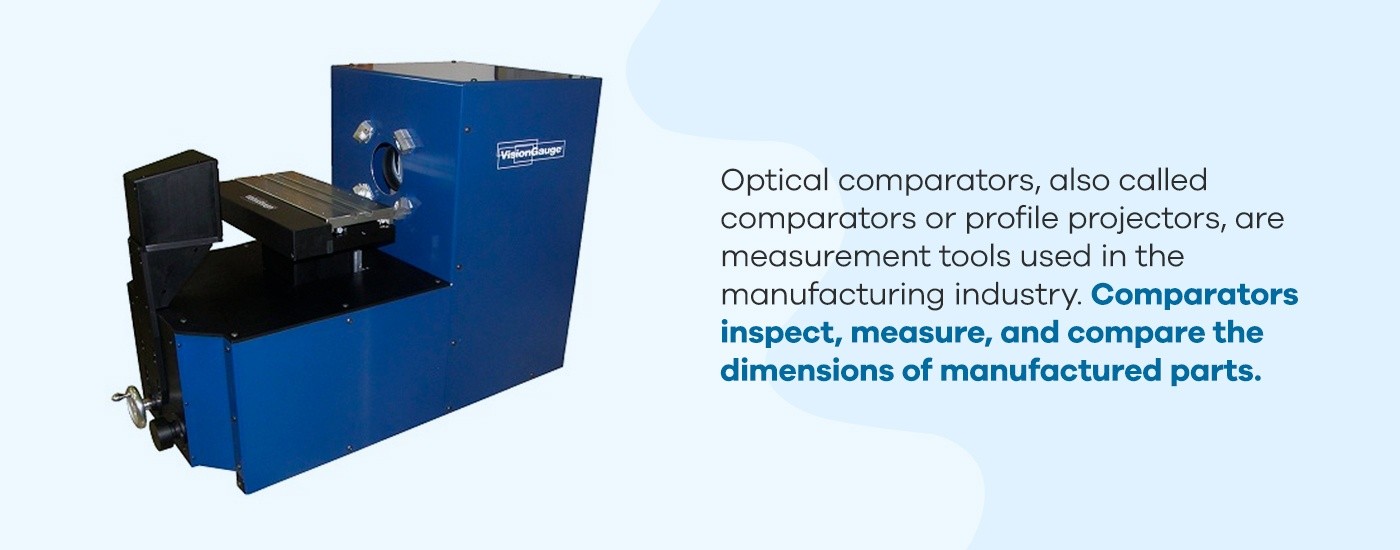An optical comparator, also known as a profile projector, is a measurement tool widely used in manufacturing for quality control. It allows for precise inspection and measurement of manufactured parts by projecting a magnified silhouette onto a screen for comparison against a standard. This guide explores the functionality, types, and applications of optical comparators, highlighting the differences between traditional and digital models.
How Does an Optical Comparator Work?
The fundamental principle behind an optical comparator is the use of optics to magnify and project the shadow of a part onto a screen. A light source illuminates the part, casting a shadow that passes through a series of lenses and mirrors. This magnified silhouette is then projected onto a screen at a fixed distance, allowing for accurate measurements. The magnification level depends on the optics and screen size, which can range from 12 to 36 inches or larger.
Three primary measurement processes are used with optical comparators:
- Silhouette Measurement: The simplest method involves directly measuring the magnified silhouette on the screen, utilizing the known magnification factor.
- Point Comparison: This method compares the silhouette to predefined points on an overlay placed on the screen. The stage holding the part is moved to align the silhouette with these points, and the movement is measured to determine dimensional accuracy.
- Software Analysis: Digital optical comparators utilize software to analyze the projected image, automating the measurement process and providing detailed data.
Traditional vs. Digital Optical Comparators
While the core optical principles remain the same, optical comparators have evolved significantly with the advent of digital technology. Traditional comparators rely on manual comparison using overlays or point-to-point measurement. This process can be time-consuming, subjective, and prone to human error.
Digital optical comparators, on the other hand, leverage advanced software and camera technology to automate the measurement and analysis process. They offer several key advantages:
- Automation: Automated measurement and analysis significantly reduce operator input and increase throughput.
- 3D Capability: Digital systems can incorporate multiple lighting techniques and even laser scanning to capture three-dimensional data.
- Enhanced Accuracy: By eliminating manual comparison, digital comparators offer higher accuracy and repeatability.
- Data Analysis: Digital systems provide quantifiable data, statistical analysis, and detailed reports for comprehensive quality control.
Applications of Optical Comparators
Optical comparators are indispensable in various industries, including:
- Automotive: Inspecting engine components, gears, and body panels.
- Aerospace: Measuring turbine blades, fasteners, and complex assemblies.
- Medical Devices: Verifying the dimensions of implants, instruments, and components.
- Electronics: Analyzing circuit boards, connectors, and microchips.
- Manufacturing: General quality control for a wide range of manufactured parts.
Choosing the Right Optical Comparator
Selecting the appropriate optical comparator depends on specific application requirements. Traditional comparators are suitable for simple parts and low-volume inspection. However, for complex parts, high-volume production, and the need for detailed data analysis, digital optical comparators offer significant advantages in terms of speed, accuracy, and efficiency. Modern digital systems streamline quality control processes, ensuring consistent and reliable measurements for even the most demanding applications. Consider factors like part complexity, required accuracy, throughput needs, and budget when making a decision.
The Future of Optical Comparators
The ongoing advancements in digital imaging and software technology continue to drive the evolution of optical comparators. Future developments are likely to focus on further automation, enhanced 3D capabilities, and integration with other metrology systems for comprehensive quality control solutions. The ability to analyze complex geometries, automate inspection tasks, and generate comprehensive reports will continue to make optical comparators an essential tool in modern manufacturing. Investing in a digital optical comparator is an investment in the future of quality control, ensuring precision, efficiency, and data-driven decision-making.

